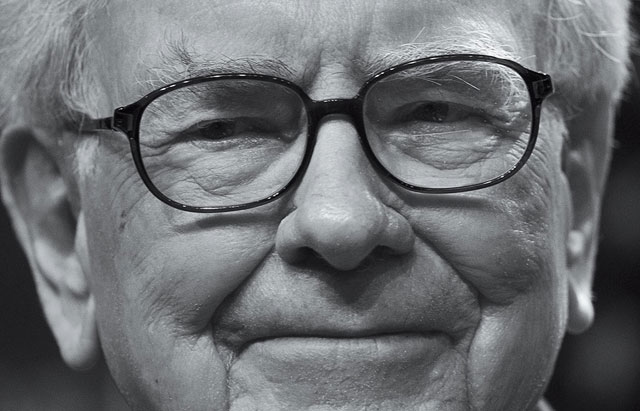sierraclub.org - sierra magazine - may/june 2013 - warren buffett's coal problem
To run his coal trains, the billionaire investor needs to seize land from a bunch of Montana cowboys. That's not going over very well.
By Marc Gunther

AP Photo/Cliff Owen
It's easy to see why Warren Buffett is called America's most admired investor. The 82-year-old chairman and CEO of Berkshire Hathaway has made gobs of money—$53.5 billion, at last count—and has pledged to give away 99 percent of it. Despite his wealth, Buffett is folksy, unpretentious, and grateful for what he describes as his good luck. He lives in the modest Omaha, Nebraska, home that he bought in 1958 for $31,500 and eats at the local Dairy Queen. (He owns the chain.)
Buffett also gets favorable attention—and deservedly so—for Berkshire's large investments in solar power, wind farms, and the Chinese electric car company BYD. When Berkshire's Iowa-based MidAmerican Energy Holdings Company bought a 579-megawatt solar photovoltaic project in California's Antelope Valley in January, the headlines read, "Warren Buffett in $2 Billion Solar Deal" and "Warren Buffett Continues His Solar Buying Spree." So influential is Buffett as an investor that solar stocks surged on the news. MidAmerican's renewable energy unit also owns a 550-megawatt solar project in San Luis Obispo County, California, and a 49 percent stake in a 290-megawatt solar plant in Yuma County, Arizona. Those are among the biggest solar projects in the world.
A subsidiary of MidAmerican, called MidAmerican Energy Company, a regulated utility with customers in Iowa, Illinois, South Dakota, and Nebraska, has helped build Iowa's thriving wind power industry. Thirty percent of its portfolio is wind-powered generation. "It has been a great and low-key leader," says Bruce Nilles, senior director of the Sierra Club's Beyond Coal campaign.
But Buffett has a problem—a coal problem. In addition to its solar and wind operations, MidAmerican Energy Holdings relies on coal for roughly half of its 18,000-megawatt generating capacity. Buffett's Burlington Northern Sante Fe (BNSF) Railway Company derives a quarter of its $20 billion in annual revenues from transporting coal, and it lobbies aggressively on the industry's behalf. Berkshire Hathaway is one of the very few major U.S. companies that don't disclose their greenhouse gas emissions, and it has opposed shareholders who ask it to do so.
Nowhere is Buffett's green reputation taking more of a beating, though, than in a remote and sparsely populated corner of southeastern Montana. Ranchers, Native Americans, and Amish farmers there are fighting to preserve their livelihoods and landscapes, which are threatened by what, if developed, would be one of the biggest coal strip mines in the West. And shipping all that coal to West Coast ports would be Warren Buffett's BNSF Railway.
"The coal will go to China, the profits will go to the coal and railroad companies, and Montana will be left to pay the costs."
This is not postcard Montana, the Big Sky Country around Yellowstone National Park where celebrities pay millions for ranches that they enjoy for a few weeks every year. Southeastern Montana is rugged and beautiful, but also arid and inhospitable, dotted with the remains of log cabins built by 19th-century homesteaders and abandoned long ago. East of Billings, the closest thing you'll find to a celebrity is a 77-year-old cowboy poet named Wally McRae, who has been honored for his poetry by the National Endowment for the Arts and whose books include the aptly named Cowboy Curmudgeon. (See "Cowboys and Coal Ash Don't Mix," March/April 2010.)
The McRaes have been ranching in the area since the 1880s, before Montana was a state. It's impolite to ask how much land Montana ranchers own or how many cattle they run—it'd be like asking New Yorkers how much money they have in the bank. I'd guess that McRae and his 50-year-old son, Clint, run about 500 cows on 30,000 acres of desolate prairie. They move their herd from pasture to pasture on the Rocker Six ranch together on horseback. "An old man and an incompetent," says Wally, drawing a good-natured laugh from Clint.
Just a few miles away is the small town (population 2,300) of Colstrip, which is, yep, named after a coal strip mine. The open-pit mine feeds a 2,094-megawatt power plant, the second-largest coal-burning plant west of the Mississippi and the dirtiest coal plant in the West. (See "High Plains Poison," March/April 2010.)
The strip mine has drained water from the aquifers that make ranching possible, but it's the power plant that really gets Wally going. (In March, the Sierra Club and the Montana Environmental Information Center sued the plant, seeking tougher air pollution controls.) Montana's environmental regulators acknowledge that its toxic coal-ash ponds have been leaking for years. "The state could be fining them $10,000 a day for the last 30 years, and you know how much they've been fined?" Wally asks. "Zero." At a community meeting, he once told a power plant executive, "Your industry has turned me into a complete asshole."
And that was before someone—someone who doesn't know Wally, apparently—drew up the latest route for the Tongue River Railroad. Arch Coal, one of America's largest coal companies, wants to stripmine the Otter Creek coal tracts in Powder River County, and the proposed 42-mile Tongue River rail line would link the mine with BNSF. (Buffett's BNSF is a one-third owner of the Tongue River line.) Nine of those miles slice through the McRaes' Rocker Six ranch. "It cuts the ranch right in half," laments Clint. Should the railroad win federal and state approval, Tongue River might be able to use the power of eminent domain to acquire the portion it needs. "Why should we have to give up our property rights for this railroad?" Clint asks.
1 | 2 | 3 |next >>